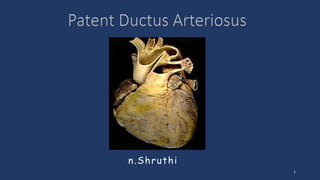This document provides an overview of the patent ductus arteriosus (PDA). It discusses the history and anatomy of the PDA, mechanisms of postnatal closure, predisposing factors, genetic factors associated with PDA, clinical presentation, diagnostic testing including echocardiography, and natural history if left untreated. Key points include that PDA is the most common congenital heart condition in neonates, involves persistent connection between the aorta and pulmonary artery, and if large can lead to heart failure if left untreated. Echocardiography plays an important role in diagnosis and assessment of severity.











































